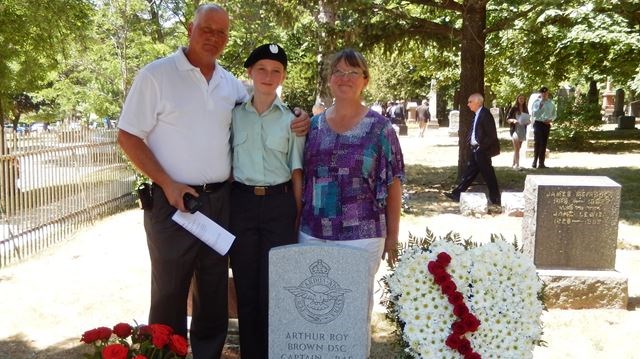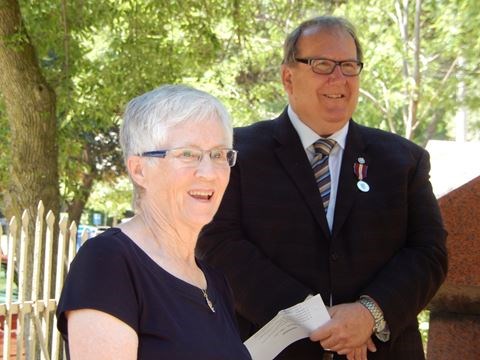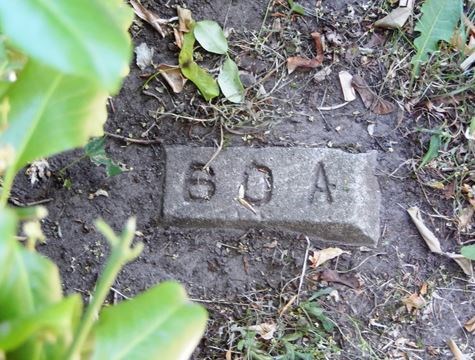Military style headstone dedicated in honour of Captain A. Roy Brown at Necropolis Cemetery
On a perfect summer day at the historic Necropolis Cemetery in Toronto, some 50 people gathered for the dedication of a military style headstone for Captain Arthur Roy Brown. Generally recognized as the fighter pilot who shot down Baron Manfred von Richthofen in the First World War, Roy Brown was born in Carleton Place and died in Stouffville.
On June 29 a dedication of the headstone was attended by representatives of the Brown family and the Roy Brown Society, and officials of the Last Post Fund, which provided the headstone. Until now, the mortal remains of Roy Brown and his wife, Edythe, were identified only by small numbered markers bearing no names.
Others in attendance included former military officers and representatives of the Royal Canadian Military Institute and the Canadian Aviation Historical Society. I was there to represent Canada’s Aviation Hall of Fame. Captain Roy Brown was installed as a Member of the Hall in June 2015. At the induction ceremonies, some 25 members spanning three generations of the Brown family were present for the event, held at the Toronto Pearson International Airport.
Since then, growing interest in obtaining appropriate recognition and a proper memorial for Brown has been the result of work by the Roy Brown Society, based in Carleton Place. As well, the efforts of the town`s Nadine Carter, now 12 and who just completed grade seven at Glad Park School in Stouffville, have done much to raise awareness of Roy Brown`s place in Canadian aviation history.
Rob Probert, president of the Roy Brown Society, welcomed participants to the commemoration event held at the cemetery. An invocation by military pastor Ben Kidd began the program, while piper Michael Maehle contributed to the pomp and dignity of the ceremony.
Roy Brown’s niece, Carol Nicholson of Oakville, spoke on behalf of the family in expressing appreciation for the Roy Brown Society and the Last Post Fund. Brown’s granddaughter Dianne Sample, who came from her home in the US, paid tribute to Roy’s remarkable wife Edythe, who lived to be 92.
Canada’s Aviation Hall of Fame, through its board of directors and operations committee, is pleased to offer its sincere appreciation to the Last Post Fund and to the Roy Brown Society. Their tireless work has resulted in acquiring a plot and placing the headstone in memory of Roy Brown and his wife, Edythe.
Roy Brown died in 1944 and was buried in Aurora, Ontario. In 1955 he was removed by his wife and cremated, and his remains were taken to Toronto. What surprised me even more was that nobody in the family knew where he was interred.
I thought I was quite clever, when after making a few phone calls and a few email inquiries, I learned that the mortal remains of Roy and Edythe were placed in different places at the Necropolis Cemetery, with no headstones to mark their places.
Then I began learning about Nadine Carter. When she was 10-years-old, as a result of a school project, she began researching Roy Brown. In 2015 she located him and three months before I knew the answer, she had visited the cemetery to place roses at his burial site.
As well, Nadine has been successful in gaining recognition of Roy Brown’s importance from three levels of government. She has spoken to her town council, enlisted the support of her MPP and Paul Calandra, her MP at the time, called for recognition of her in the House of Commons.
Brown is best known for the famous aerial battle with Manfred von Richthofen, the “Red Baron,” on April 21, 1918, resulting in the death of Germany’s most famous combat pilot. Even though Brown was an ace pilot himself, with about a dozen victories in the First World War, he was much more than a combat pilot himself. He was a squadron commander of the Royal Air Force and a leader of men, setting an example for them with his flying skill, and never losing one man in his command.
Brown learned to fly in 1915 at the Wright School of Aviation in Dayton, Ohio and was given a pilot’s certificate after less than six hours of flying primitive airplanes in those very early days of aviation. He then joined the Royal Naval Air Service and went overseas to serve Canada in the war.
I believe that what Brown suffered in the war helped lead to his early death at only 50 years of age. He was flying up to three stressful combat missions a day in difficult conditions at altitudes as high as 20,000 feet or more in extremely cold temperatures in aircraft with open cockpits and with no additional oxygen. He also endured flying accidents, and was hospitalized for serious injuries.
War took its toll on the Brown family in other ways. Brown’s brother, Horace, enlisted in the army with the Canadian Infantry to serve in the First World War. Later he flew as a Lieutenant with the Royal Air Force. Sadly, after surviving the war, he was a victim of the Spanish Flu epidemic and died in hospital in England in February, 1919. He is buried at Carleton Place.
After the war, Brown never lost interest in flying. He became a pioneer in civil aviation, establishing his own company, General Airways Limited, which operated in Ontario, Québec and Manitoba through the Depression years until 1940. He then settled at Stouffville, and operated a farm on land which is now the location of the Rolling Hills Golf Club. He died there on March 9, 1944.
Carleton Place visit
In early June this year I had the opportunity to visit the beautiful town of Carleton Place, where Brown was born. I saw Moore House, the lovely restored log building on Bridge Street, where the Roy Brown Society has exhibits for him. I saw the house where Roy was born, where the society last year placed a marker on June 4, 2015, the first Roy Brown Day, held on the same day Brown was inducted to the Hall of Fame.
I saw the stone building of the grist mill operated by Brown’s grandfather and father. I visited the Carleton Place and Beckwith Heritage Museum that occupies the 1872 building that was formerly Victoria School. There I saw displays dedicated to Brown, and the little rocking horse he rode as a child.
I found the cottage still in use that was built by the Brown family in 1913 beside Mississippi Lake, where Brown spent time with his family. I have I have seen the plaque dedicated to Brown at Memorial Park, and I have read letters that he wrote home during the war.
I want to mention two friends who were important in Brown’s life. One is Wilfrid “Wop” May, who Brown knew while attending high school at Edmonton in 1913-1915. It was Wop May whose life Brown saved in the aerial battle with the Red Baron. A mural on the side of a building in Carleton Place depicts that battle.
The two men remained friends and stayed in contact until Brown died in 1944. Recently I visited the grave of Wop May and his wife, Violet, who are buried in Edmonton. During the Second World War, Wop was manager of No. 2 Air Observer School in Edmonton, at a hangar where my father trained with the Royal Canadian Air Force as a navigator. I started my own years with RCAF 418 Squadron in that building. That wartime hangar is now home of the Alberta Aviation Museum.
Like Brown, Wop was an ace fighter pilot, a Captain in the Royal Air Force, and a decorated war hero who received the Distinguished Flying Cross. Like Brown, Wop had undergone the same rigours of flying in the First World War. He, too, died as a young man, at the age of 56 in 1952.
Brown’s best friend, Sterne Edwards, was like a brother to him. Sterne learned to fly with Brown in 1915 and like him went overseas to fly with the Royal Naval Air Service. Edwards was also an ace fighter pilot and rose to the rank of Captain in the Royal Air Force. Like Brown, he was twice decorated with the Distinguished Service Cross. The day after Armistice Day in 1918, Sterne went for a flight to celebrate the end of the war.
Tragically, he crashed his airplane and died of injuries a few days later at the age of 25. His death was a great loss for Brown, who was unable to speak after unveiling a plaque for Edwards at St. James Anglican Church in Carleton Place. Edwards is buried in Tadcaster Cemetery in Yorkshire, England, and named on the War Memorial in Carleton Place.
Canada’s Aviation Hall of Fame, extends its gratitude for the tireless work of the Roy Brown Society and the great support of the Last Post Fund. Thanks to those organizations, Brown is now well remembered not just in his home town of Carleton Place, but also with an appropriate headstone, a hundred years after he served Canada while flying in the First World War with the Royal Naval Air Service and the Royal Air Force, in the days before Canada had an air force of its own.
John Chalmers is a historian with the Canadian Aviation Hall of Fame
Originally Published on: July 25, 2016 John Chalmers - Carleton Place Almonte Canadian Gazette


